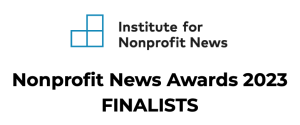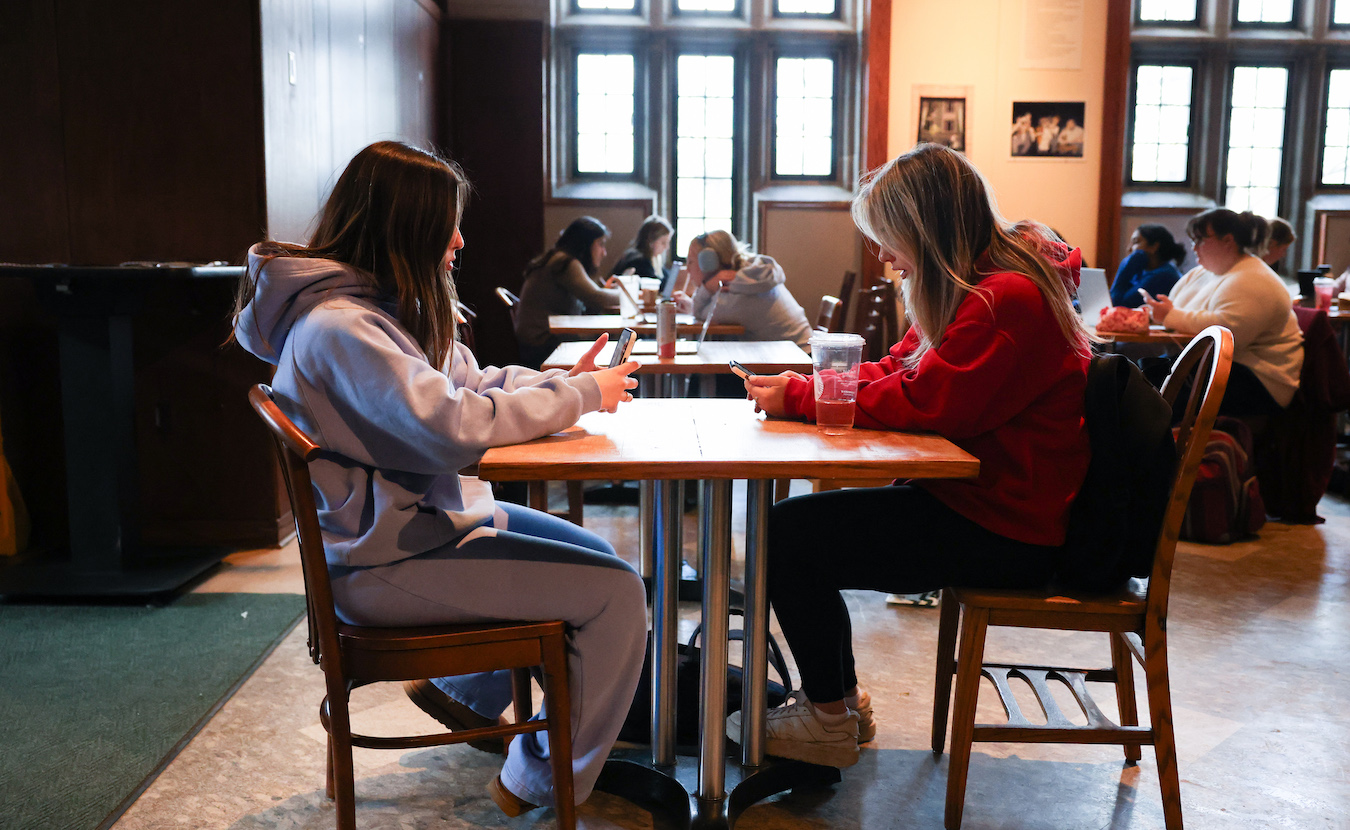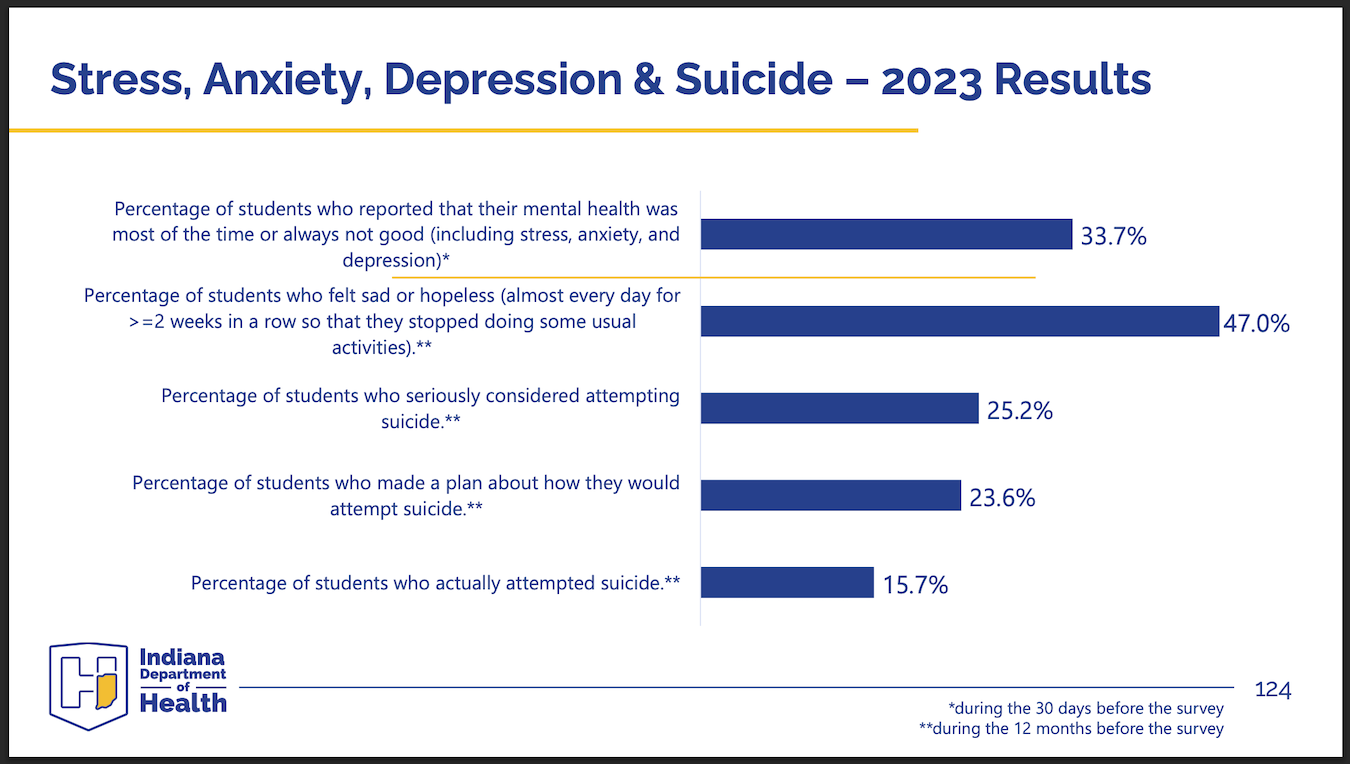Starting last year, Morgan Terry, a social worker at Tri-North Middle School, began to see a “ramping up” of students presenting with increased emotional needs. She counseled kids experiencing sadness, a sense of helplessness, depression, and even suicidality, or the risk of suicide. This year, she’s seen a significant uptick in the same issues.
Terry works with two counselors but is the only social worker who manages students’ varying mental health needs. At the start of the 2024 school year, Tri-North had 600 students in the 7th and 8th grades who had come from six elementary schools. Last year, Terry saw 400 students at one point or another during the school year for their mental health.

Morgan Terry, a social worker at Tri-North Middle School. | Photo by Benedict Jones
Terry’s experience is reflected by national statistics. According to the article “2023 Mental Health and Suicide Risk Among High School Students and Protective Factors — Youth Risk Behavior Survey” in the CDC’s Morbidity and Mortality Weekly Report, 39.7 percent of students had persistent feelings of sadness and hopelessness, 28.5 percent experienced poor mental health, 20.4 percent seriously considered suicide, and 9.5 percent had attempted suicide.
The Indiana Department of Health 2023 Youth Risk Behavior Survey found that, on average, 15.7 percent of 9th- through 12th-grade students actually attempted suicide. The report also found that, on average, 25.3 percent of 9th- through 12th-grade students seriously considered attempting suicide, and 23.8 percent made a plan about how they would attempt suicide.
The student groups at the most risk are female students and LGBTQ+ students. For female students, 52.6 percent had feelings of sadness and hopelessness, 38.8 percent experienced poor mental health, 27.1 percent considered suicide, and 12.6 percent had attempted suicide. For LGBTQ+ students, those percentages go even higher: 65.7 percent had feelings of sadness and helplessness, 53.5 percent had poor mental health, 41 percent considered suicide, and 19.7 percent attempted suicide.
In Indiana, the report “Workforce Snapshot Assessing Indiana’s School-Based Behavioral Health” by the Bowen Center for Health Workforce Research and Policy revealed that in 2023, nearly half of Indiana high school students surveyed faced depression, and a quarter of those students had developed a suicide plan.
Suicide has been one of the three top causes of death for Hoosier children ages 10 to 19 for the past seven years. Why are mental health issues increasing so dramatically among today’s youth? Could the cause of this rise in mental illness be attributed to the pandemic, an “Echo Pandemic,” social media, political threats on their identity, or all these factors?
The ‘Echo Pandemic’
First, mental health issues that existed pre-pandemic continue to carry over today. Pre-pandemic, youth and adolescents were already experiencing increasing mental health challenges that the pandemic merely exacerbated. The report “Youth Risk Behavior Surveillance System” by the Centers for Disease Control and Prevention (CDC) found that in the ten years leading up to the COVID-19 pandemic, “students’ persistent feelings of sadness and hopelessness increased by about 40 percent among high school students.”
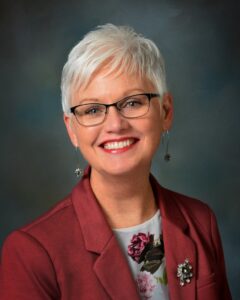
Jan Desmarais-Morse, executive director of the Indiana School Counselor Association. | Courtesy photo
“Prior to the pandemic, my school counseling team and I had already seen a rise in levels of anxiety and mental health issues in our middle school students, perhaps starting with the financial crisis of 2008,” said Jan Desmarais-Morse, executive director of the Indiana School Counselor Association. “Our county [Elkhart], where most of the workforce is engaged in manufacturing, was heavily hit by this crisis. Added to that were other societal and political issues that caused angst within the family to trickle down to the children. At that time, we were seeing an increase in students who were not developing the ability to self-regulate during times of stress or challenge, thereby exhibiting increased debilitating levels of anxiety.”
A McGill University study reported that the pandemic expanded social disparities like economic conditions, parental mental health, social isolation, and increased family stressors for children. Children living in poverty or child-protective-status situations had low resilience when faced with lockdowns, food insecurity, and loss of mental health services, all of which have contributed to increased mental health challenges.
Kodee Walls, director of Counseling and Psychological Services (CAPS) at Indiana University, said she is now seeing students who traditionally might not have come to college because of their mental illness, such as schizophrenia. “We are getting a lot more students who have been in treatment previously for some pretty complex stuff,” said Walls.
The IU CAPS program offers individual mental health counseling and services, psychiatric care, group counseling, and other mental health services. It is supported by student fees and offered through the IU Student Health Center.
Second, nationally and in Indiana, new laws and a rising anti-transgender sentiment have exacerbated mental health issues for certain students. Suicidality is especially persistent among subgroups of youth like females and LGBTQ+ youth. These groups are considered to be among the most vulnerable to mental health issues, according to a 2024 report by The Trevor Project.
“
We were seeing an increase in students who were not developing the ability to self-regulate during times of stress or challenge, thereby exhibiting increased debilitating levels of anxiety.
”
—Jan Desmarais-Morse
The American Civil Liberties Union is tracking 533 legislative bills nationwide curtailing LBGTQ+ freedoms this year. Indiana had five bills, all of which failed. However, in 2023, eighteen bills were initiated, three of which were signed into law.
Key findings in the Trevor Project report indicate that such legislation severely impacts the mental health of LGBTQ+ young people. For instance, 90 percent of LGBTQ+ young people surveyed said that recent politics negatively affected their well-being. Nationally, there has been a strong push by Donald Trump against transgender people.

Kodee Walls, director of Counseling and Psychological Services (CAPS) at Indiana University. | Photo by Benedict Jones
In addition, growing evidence demonstrates that the COVID-19 pandemic may have contributed to the rise of mental illness in adolescents and youth by interrupting adolescent development patterns for forming relationships and imposing social isolation.
Although long-term studies are scarce, the 2024 study “Longitudinal Changes in Youth Mental Health From Before to During the COVID-19 Pandemic” found that the pandemic was associated with changes in youth mental health, though not all of the 1,229 youth surveyed experienced the pandemic in the same way.
A more extensive Finnish study between 2015 and 2023 surveyed 722,488 students with a mean age of 15.8 years. This study found elevated levels of mental health problems among young people during the COVID-19 pandemic. It also found that the proportion of participants with generalized depression and social anxiety symptoms increased from pre-COVID-19 levels in 2021 and remained at these elevated levels in 2023 among all study groups.
Finally, a review of global studies on the impact of the pandemic found that many adolescents experienced increased mental health problems, especially those who were already vulnerable before the pandemic. All studies pointed to an increase in depressive and anxiety symptoms in youth.
“I think that what we’re going to find are the consequences of COVID is the disconnection, and those consequences are that now people don’t know how to navigate some of the basic social functions,” said Walls. What’s happening in mental health today, said Walls, is the “Echo Pandemic” — “the mental health crises that we’re going to see after the fact.”
Social media’s influence
The use of social media by youth is ubiquitous. In fact, according to the US Surgeon General’s 2023 Advisory on Social Media and Youth Mental Health, up to 95 percent of teenagers use social media. For children ages 8 to 12, the usage rate is 40 percent. The report further found widespread use of social media has contributed to mental illness issues such as body dissatisfaction, eating disorders, hate-based content, self-harm, and even suicide content.

The American Psychological Association reported in 2024 that 41 percent of teens with the highest rate of social media use said they had poor to very poor mental health. | Photo by Benedict Jones
The American Psychological Association reported in 2024 that 41 percent of teens with the highest rate of social media use said they had poor to very poor mental health, with 10 percent of that group expressing suicide ideation and intent to self-harm.
Social media, in conjunction with the pandemic, has also contributed to rising rates of mental illness. The pandemic’s lockdowns and social distancing increased students’ use of cellphones and computers to communicate. According to a report from Common Sense, a tech research and consumer advocacy group, screen time from 2019 to 2021 increased from 4 hours 44 minutes to 5 hours 33 minutes among tweens and from 7 hours 22 minutes to 8 hours 39 minutes for teenagers or a more than 17 percent increase for each group; these numbers do not include time spent in school or doing homework.
A senior at Bloomington High School North, Lauren Reynolds uses social media but thinks it can be good and bad. “Cellphones are an attachment that I don’t want but can’t help having,” she said. Still, during the pandemic, she relied on social media to stay connected with her friends and the outside world. “I would definitely say that the pandemic increased my use of social media.”
According to an article in the journal World Psychiatry, social connections are critical for mental and physical health and can also help moderate and aid recovery even from significant mental health issues. While loneliness and isolation are associated with poor mental health, the long-term implications of the pandemic and the increasing use of digital technologies may worsen these trends.

Claire Sunkel, a licensed mental health counselor in Bloomington. | Courtesy photo
Claire Sunkel is a licensed mental health counselor in Bloomington who works with adolescents and young people. She believes that isolation is a big issue for today’s teens but that it can be cut both ways.
“Social media applications can bring much connection,” said Sunkel, “but they can also pull them away from connections in real life.” The pandemic and lockdowns, she said, really impacted people’s social networks and those formative social years for adolescents and young people.
Tri-North social worker Terry agrees. “This year [emotional needs] are very significant, and it seems like it is related to what these kids experienced during COVID and the skills they missed out on during that time,” said Terry. “I’m seeing a lot of anxiety and a real lack of social skills when it comes to dealing with any social friction.”
“Anxiety and depression have certainly increased since 2020,” said Monica Black, a clinical coordinator at Youth Services Bureau. “It is my opinion that the widespread use of smartphones has also contributed to this condition.”
Black works with Monroe County Community School Corporation, providing community-based counseling and services to children and their families, including individual and family therapy.
Kids with mental health issues can’t leave those challenges at home. As a result, helping students cope with mental health issues while at school has become a priority for school administrations. Strong evidence links student mental health support to academic and social success, leading many schools to rely more heavily on school counselors and social workers.
It is critical for primary and secondary schools to identify what type of care is needed and who is best qualified to provide it. Furthermore, school leadership must do a better job learning more about school counselors and how they can be used to address mental health issues, said Desmarais-Morse.
In most schools, school counselors and social workers can fill those needs. But in recent years, a question of priority has arisen: Should their focus be on mental health issues, administrative issues, or both?
Social working vs. counseling
A recent Indiana School Counselors Survey found that Indiana has one counselor for every 351 students, higher than the recommended ratio of 1 to 250 students. However, counselors spend an average of 15 percent of their time on tasks like test monitoring, attendance, and other non-counseling duties. As of the 2023–2024 school year, Indiana had only 2,080 school counselors statewide for more than one million students. Monroe County had only 29 school counselors.
“
Suicide has been one of the three top causes of death for Hoosiers ages 10 to 19 for the past seven years.
”
—Indiana Youth Institute
“The American School Counselor Association recommends that school counselors spend 80 percent of their time in direct and indirect service to students,” said Desmarais-Morse. “But the Indiana School Counselor survey indicated that school counselors are unable to meet this goal due to higher caseloads and inappropriate duties.”
The disparity is even greater for school social workers. The 2023 Indiana Commission on Improving the Status of Children reports that Indiana currently has 2,788 students to 1 school social worker when the National Social Workers Association recommends a ratio of 250 to 1. Monroe County has only 21 school social workers for more than 10,000 students, or about 476 to 1.
If a student cannot get help at school through their school social worker, they can look for care outside the school system through social service agencies or private contractors, or sometimes the school delivers those services at school. According to Terry, Centerstone provides services twice weekly at Tri-North, and the school also works closely with the Youth Services Bureau and Adult and Child Health Services.

The National Social Workers Association recommends a ratio of 250 students for every school social worker. Indiana has a ratio of 2,788 to 1. The ratio in Monroe County is about 476 to 1. | Photo by Benedict Jones
Unfortunately, said Desmarais-Morse, “access to mental health services [for youth] in Indiana is scarce.” In an October 2024 article for the Indiana Youth Institute, its president and CEO, Tami Silverman, cited a 2024 Mental Health America finding that two in three Indiana youth with major depression did not receive necessary treatment. Silverman also noted a National Survey of Children’s Health finding that 28 percent of Indiana parents reported difficulty accessing mental health care for their children in 2022. Indiana has only one mental health provider for every 500 Hoosiers, and as of 2023, all 92 counties were experiencing a shortage of mental health providers.
These challenges, said Desmarais-Morse, seem insurmountable. “The insufficient availability of local mental health resources that serve our young people is also especially challenging for rural communities that do not have access to local mental health providers.” Even finding emergency placement for a youth with suicide ideation is extremely difficult, she said.
Now, the remaining question is whether the rate of mental illness outpaces the little progress state leaders have made in addressing it. Based on the CDC’s Youth Risk Behavior Survey Data Summary and Trends Report, which shares ten-year trends, the report acknowledges that there has been insufficient time to measure the outcomes. Now, with the national threat to cut Medicaid and other safety net programs, funding treatment for mental illness is at risk, especially for those with limited social means. Given that the effects of the COVID-19 pandemic and the Echo Pandemic are still present and social media use has ramped up among youth, the three bills in the recent Indiana legislative session, SB 36, SB 358 (amended to remove school counselor provisions), and SB 359, seem insufficient to address this growing problem.
“The years following the pandemic have seen continued societal upheaval, which has negatively affected the mental health of students, said Desmarais-Morse. “Much more needs to be done to address the needs of our youth, which produces results and provides much-needed resources.”
Disclosure: The writer is related to one of the sources, Morgan Terry.
Resources
If you or someone you know is thinking about suicide and seeking emotional support, crisis lines are available via phone, chat, or text. If a suicide attempt has occurred, call 911 immediately or go to a nearby hospital emergency room.

The Indiana University Counseling and Psychological Services (CAPS) program offers counseling and other mental health services at the IU Student Health Center. | Photo by Benedict Jones
From the Indiana Suicide Prevention website:
- 988 Suicide & Crisis Lifeline
- National Suicide Prevention Lifeline: 800-273-8255 (TALK)
- National Suicide Prevention Lifeline Online Chat Services
- Crisis Text line: Text IN to 741741 for free, 24/7 crisis counseling. We’re here for you.
- Trevor Project Lifeline (confidential suicide hotline for LGBTQ+ youth): 866-488-7386
- TrevorChat
- TrevorText: Text START to 678-678.
- Veterans Crisis Line (for military service members, veterans, and family): Call 800-273-8255 and press 1
- Text 838255
- Support for deaf and hard of hearing: 800-799-4889
- Homeless Veterans Chat
- Youthline
Other resources
IU Student Health Center, Counseling and Psychological Services (CAPS), 600 N. Eagleson Ave., Bloomington, IN 47405, Office hours: Monday through Friday, 8 a.m.–4:30 p.m., 812-855-5711
Catholic Relief Services offers services for young children dealing with mental health issues, including a 10-year-old program at Fairview Elementary: (812) 332-1262.
Centerstone of Bloomington offers counseling and psychiatric services, 812-269-5092.
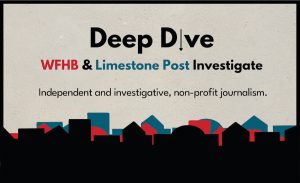 Deep Dive: WFHB & Limestone Post Investigate
Deep Dive: WFHB & Limestone Post Investigate
The award-winning series “Deep Dive: WFHB and Limestone Post Investigate” is a journalism collaboration between WFHB Community Radio’s Local News Department and Limestone Post Magazine. Deep Dive debuted in February 2023 as a year-long series, made possible by a grant from the Community Foundation of Bloomington and Monroe County. The Community Foundation also helped secure a grant from the Knight Foundation to extend the series for another year.
In the series, Limestone Post publishes an in-depth article about once a month on a consequential community issue, such as housing, health, or the environment, and WFHB covers related topics on Wednesdays at 5 p.m. during its local news broadcast.
In 2023, Deep Dive was chosen by the Institute for Nonprofit News as a finalist for “Journalism Collaboration of the Year” in the Nonprofit News Awards held in Philadelphia. And in April 2024, the series brought home seven awards from the “Best in Indiana” Journalism Contest by the Society of Professional Journalists. Read more about the awards.
Here are all of the the Deep Dive articles and broadcasts so far:
Housing Crisis
Limestone Post article by Steve Hinnefeld, published February 15, 2023:
Deep Dive: Struggling with Housing Supply, Stability, and Subsidies, Part 1
WFHB reports:
Steve Hinnefeld won 1st place for “Non-Deadline Story or Series” in the Indiana Pro Chapter of the Society of Professional Journalists “Best in Indiana” Journalism Contest for parts 1 and 2 of this housing series. The staff of WFHB won 2nd place for “Coverage of Social Justice Issues” for its programs “Deep Dive: Housing Crisis.”
Housing Crisis Solutions
Limestone Post article by Steve Hinnefeld, published March 15, 2023 | photography by Jim Krause
‘No Silver Bullet’: Advocates, Officials Use Many Tactics on Housing Woes
WFHB reports:
Opioid Settlement Fund Investigations
Limestone Post article by Rebecca Hill, published April 12, 2023 | photography by Benedict Jones
How Will Opioid Settlement Monies Be Spent — and Who Decides?
WFHB reports:
IU Tree Inventory
Limestone Post article by Laurie D. Borman, published May 17, 2023 | photography by Jeremy Hogan
Trees Do More Than Add ‘Charm’ to IU Campus
WFHB reports:
Indiana Power Grid
Limestone Post article by Rebecca Hill, published June 21, 2023 | photography by Benedict Jones
The Power Struggle in Indiana’s Changing Energy Landscape
Rebecca Hill won 1st place for “Medical or Science Reporting” in the Indiana Pro Chapter of the Society of Professional Journalists “Best in Indiana” Journalism Contest for this article.
WFHB reports:
Lake Monroe Survival
Limestone Post article by Michale G. Glab, published August 16, 2023 | photography by Anna Powell Denton
How Healthy Is Lake Monroe — and How Long Will It Survive?
Michael G. Glab won 3rd place for “Business or Consumer Affairs Reporting” in the Indiana Pro Chapter of the Society of Professional Journalists “Best in Indiana” Journalism Contest for this article.
WFHB reports:
Indiana Lawmakers Attack Public Schools
Limestone Post article by Steve Hinnefeld, published September 13, 2023 | photography by Garrett Ann Walters
Local Parents, Educators Face ‘Attack’ on Public Schools from Indiana Lawmakers
WFHB reports:
On Saving the Deam Wilderness
Limestone Post photo essay by Steven Higgs, published October 18, 2023
On Saving the Deam Wilderness and Hoosier National Forest | Photo Essay
Steven Higgs won 2nd place for “Multiple Picture Group” in the Indiana Pro Chapter of the Society of Professional Journalists “Best in Indiana” Journalism Contest for this photo essay.
WFHB reports:
Food Insecurity, Part 1
Limestone Post article by Christina Avery and Haley Miller, photography by Olivia Bianco, published December 18, 2023
One Emergency from Catastrophe: Who Struggles with Food Insecurity?
Christina Avery and Haley Miller won 1st place for “Coverage of Social Justice Issues” in the Indiana Pro Chapter of the Society of Professional Journalists “Best in Indiana” Journalism Contest for this article.
WFHB reports:
Food Insecurity, Part 2
Limestone Post article by Christina Avery and Haley Miller, photos by Olivia Bianco, published March 13, 2024
‘Patchwork’ of Aid for Food Insecurity Doesn’t Address Its Cause
WFHB report:
What’s at Stake in the Debate Over Indiana’s Wetlands
Limestone Post article and photos by Anne Kibbler, published May 15, 2024
What’s at Stake in the Debate Over Indiana’s Wetlands?
WFHB reports:
- Wetlands (Part 1), May 22, 2024
- Wetlands (Part 2), May 29, 2024
- Wetlands (Part 3), June 7, 2024
- Wetlands (Part 4), June 12, 2024
Resilience Amid Hardship: Refugees Find Challenges, Opportunities in Bloomington
Limestone Post article by Brookelyn Lambright, Karl Templeton, and Brenna Polovina from the Arnolt Center for Investigative Journalism, published August 1, 2024
Resilience Amid Hardship: Refugees Find Challenges, Opportunities in Bloomington
WFHB reports:
- Refuge in Indiana (Part 1), August 7, 2024
- Refuge in Indiana (Part 2), August 14, 2024
- Refuge in Indiana (Part 3), August 21, 2024
- Refuge in Indiana (Part 4), August 28, 2024
Apprenticeships Work for Some High School Students But Not All
Limestone Post article by Steve Hinnefeld, photography by Benedict Jones, published September 24, 2024
Apprenticeships Work for Some High School Students But Not All
WFHB reports:
- Apprenticeships (Part 1), October 9, 2024
- Apprenticeships (Part 2), October 16, 2024
- Apprenticeships (Part 3), October 30, 2024
Goal of BPD and Social Support Team Is ‘To Help People’
Limestone Post article by Haley Miller, published November 26, 2024
Goal of BPD and Social Support Team Is ‘To Help People’
WFHB reports:
- Police and Social Work, January 29, 2025
- Police and Social Work (Part 2), February 5, 2025
- Police and Social Work (Part 3), February 26, 2025
Political Polarization Hurts Communities — What Can Be Done?
Limestone Post article by Marjorie Hershey, photos by Jeremy Hogan/The Bloomingtonian, published January 26, 2025
Political Polarization Hurts Communities — What Can Be Done?
WFHB reports:
- Political Polarization, (Part 1), March 19, 2025
- Political Polarization, (Part 2), March 27, 2025
- Political Polarization, (Part 3), April 2, 2025
Mental Health Issues Are Increasing Dramatically Among Hoosier Youth
Limestone Post article by Rebecca Hill, photography by Benedict Jones, published April 3, 2025
Mental Health Issues Are Increasing Dramatically Among Hoosier Youth
WFHB reports:
